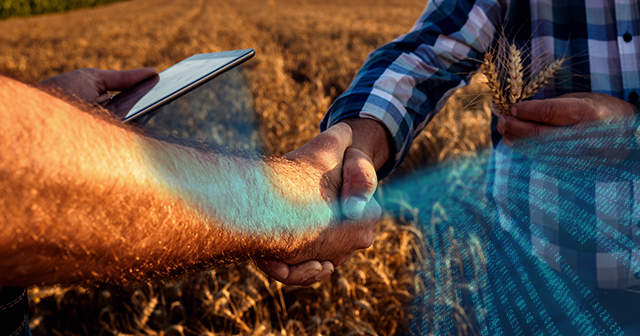When it comes to data, the more you have, the more reliable your results. Analyzing sales from just one market isn’t going to give you an accurate representation of what’s happening in all of your markets. The same is true for farm sustainability data. Evaluating just one or two inputs that can change carbon emissions or sequestration isn’t as complete a picture as analyzing multiple sustainability measures.
Why are we talking about the accuracy and reliability of farm carbon emissions data? Because it’s the future of quantifying sustainable farming practices — and it has a much more far-reaching effect than just agriculture. For example, here are three instances of how farm carbon emissions data will be used now and in the future by consumer-packaged goods (CPG) companies — in particular, food, beverage, and pet food companies.
1. To reduce value chain emissions
Environmental, social, and governance (ESG) commitments are embedded in the operation of many CPG companies. Reducing carbon emissions is typically part of their environmental goals, and for food, beverage, and pet food companies, that includes sourcing ingredients grown with a low carbon footprint.
2. To meet consumer demands for sustainably produced food
In the past, knowing where food products came from (country of origin labeling) was one of the top concerns for many consumers. Now, the concern is not only where a food product came from but also how its ingredients were grown. Purchasing sustainably grown ingredients meets increasing consumer demand for food products to be produced more sustainably.
Research by McKinsey and NielsenIQ looked at consumer spending behavior and revealed that, in many CPG categories, there was a link between ESG-related claims and consumer spending. Products that made ESG-related claims on their packaging averaged 28% cumulative growth over a five-year period (2017 to 2022) versus 20% for products without ESG claims. In two-thirds of the categories studied, products that made ESG-related claims grew faster than those that didn’t, including in 11 out of 15 food categories.
3. Scope 3 reporting requirements
Upcoming Greenhouse Gas Protocol Scope 3 emission reporting requirements will entail companies to report the amount of carbon emitted during the production of the ingredients they purchased. Scope 3 or value chain emissions are carbon emissions from assets that the organization indirectly affects but that they do not own or control and typically represent most of an organization’s greenhouse gas emissions. A reliable and accurate calculation of the carbon emitted and sequestered will be important for reporting to the company’s stakeholders and government agencies.
The future of farm sustainability data is here
So how can food companies source ingredients with a low carbon footprint and obtain the data they need for Scope 3 reporting and their own ESG commitments?
In two-thirds of the categories studied, products that made ESG-related claims grew faster than those that didn’t.
Enter EcoField™ data, a uniquely blended and validated data set that offers unprecedented scale and insights into field-level sustainable farm practices and carbon outputs. EcoField data calculates the sustainability impact of each bushel or ton and allows easy tracking, management, and reporting of the impact sustainable farming practices have on carbon emissions.
EcoField data delivers comprehensive sustainability insights
As we said in the beginning, the more data you have, the more reliable and accurate your results. EcoField data doesn’t just use one or two sustainable farming practices to calculate carbon emissions and sequestration. It uses the most comprehensive, field-level data on more than 50 sustainable agriculture practices and inputs that impact carbon emissions, soil health, and water conservation. These indicators include fertilizer and crop protection usage, irrigation, cover crop and tillage practices, and equipment emissions.
EcoField data uses the most comprehensive, field-level data on more than 50 sustainable agriculture practices and inputs.
EcoField data Inputs
- Soil type
- Tillage type
- Cover crop used
- Cash crop planted
- Fertilizer type
- Nitrogen application rate
- Irrigation used
- Crop drying used
- Pesticide category
- Machinery used
- Crop soil moisture
- Crop residue removal
- Nitrification inhibitor used
- Soil organic matter percent
How does EcoField data work?
EcoField data uses farm data input, remote sensing, estimation, modeling, and verification to complete the most accurate assessment of farm sustainability data possible at scale. The end result of EcoField data calculations is a single value — the average carbon dioxide equivalent (CO2e) emissions (kg/acre) for each field. The CO2e is used to compare emissions from all types of greenhouse gases (carbon dioxide, methane, nitrous oxide, and fluorinated gases). Food companies can use this value to report the carbon emissions of ingredients they purchased, including corn, soybeans, winter wheat, spring wheat, barley, cotton, rice, peanuts, and grapes (vines) across 35 U.S. states.
The most accurate assessment of farm sustainability data possible, at scale.
Below is an example of the EcoField data dashboard output showing the total average CO2e emissions (kg/acre) as well as for each source. In this example, 99 kg/acre of CO2e emissions were sequestered due to sustainable farming practices.
Output from EcoField data displays the average CO2e emissions by source
Avg. CO2e emissions (kg/acre) by source
Total
266
Embedded emissions from manufacturing
105
39% percentage of total
Emissions released from fertilizer applied to soil
143
54% percentage of total
Emissions from irrigation
0
0% percentage of total
Emissions from use of tractors and other machinery
34
13% percentage of total
Emissions/sequestration from management practices
-99
-37% percentage of total
e.g., change in tillage, use of cover crops, tree acres, etc.
Emissions from pesticide use/application
6
2% percentage of total
Emissions from crop drying down
43
16% percentage of total
Emissions caused by removal of crop residue(s)
34
13% percentage of total
The food industry is moving closer and closer toward sustainable food production across the entire industry — from farm to fork. By helping to source ingredients with a low carbon footprint, EcoField data delivers food, beverage, and pet food companies the insight and tools they need to future-proof their business.










